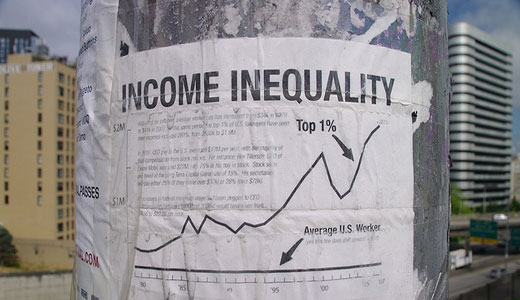
The level of income inequality stretches much higher in the United States than in the other developed countries, like Europe or Canada. Now a report from the International Labor Organization (ILO) shows that U.S. inequality has literally gone off the chart.
Income inequality in the United States is soaring so high, in fact, that the authors of the ILO’s new 2013 World of Work report couldn’t even place the United States on the same graph with the other 25 developed countries their new study examines.
Income inequality reflects the sum total of all the differences between the incomes enjoyed by different households in a country. Differences between rich and poor households, rich and middle-income households, middle-income and poor households all enter into total income inequality.
Researchers usually measure income inequality using a statistic called the “Gini coefficient.” The Gini coefficient runs from a minimum of 0 (perfect equality in incomes across all households) to 100 (one rich household gets all the income for an entire country).
The ILO report places the US Gini coefficient at 47.7, or almost half way toward the extreme where one rich household gets everything and everyone else gets nothing.
By comparison, the levels of inequality in the other 25 developed countries studied all fall in a band between 20 and 35.
Even worse, in America inequality is not only high but rising. The United States is one of only three developed countries where income inequality rose during the recession of 2008-2009, then continued rising through the lackluster recovery of 2010-2011.
The other two are Denmark and France. Both these countries had much lower levels of inequality to start with. By 201, Denmark’s inequality had risen into the high 20s and France’s inequality into the low 30s.
In the United States inequality sat at 46.3 before the recession, moved to 47.0 in 2010, and rose further to 47.7 in 2011.
Rising inequality has hit the American middle class particularly hard. But America’s middle class decline began well before the recession hit in 2008. Every year fewer and fewer Americans qualify as middle class, and those who do have lower and lower incomes.
The share of U.S. adults living in middle-income households, the new ILO report notes, dropped from 61 to 51 percent between 1970 and 2010, and the median incomes of these households fell 5 percent.
Where has the middle class held its own in recent decades? Well, in Denmark and France, among other countries. The country with the largest middle class according to the ILO’s calculations is Norway, where about 70 percent of the population rate as middle class.
In the United States today only about 52 percent of the population can claim middle-class status.
The World of Work report concludes that the “middle class in the United States and around the world is suffering from “long-term unemployment, weakening job quality, and workers dropping out of the labor market altogether.” Things have been bad for a long time, but the recession has made them far worse.
The ILO, founded in 1946, now operates a specialist agency of the United Nations. The world’s employers and workers are equally represented on its governing board, alongside the representatives of 28 governments, including the United States government.
Different international organisations use different data sources for comparing inequality levels across countries. The ILO World of Work report uses raw data from the Census Bureau for the United States and from Eurostat for European countries.
The empirical evidence says that we can reduce inequality and bolster the middle class by putting people back to work. But that will take government action.
Richard Easson is chairman of ‘Respect For the Unemployed & Benefit Claimants.’
Photo: mSeattle/Flickr (CC)










